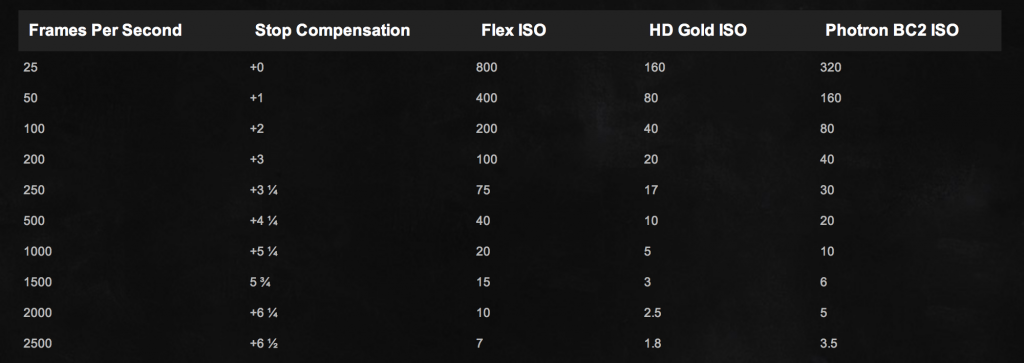LIGHTING FOR HIGH SPEED – PHANTOM
Lighting issues are not specific for Phantom cameras but for high frame rate moving pictures in general. Even with the great sensitivity of modern cameras such as the Phantom Flex, be prepared to use a considerable amount of light. Shooting at a frame rate of 1000fps requires 5.25 times more light than at 24 or 25 fps.

Beyond illumination, the largest issue in high-speed lighting is flicker. When powered by alternating current (AC) electricity, the lamps power cycles 50 or 60 times per second (depending on the country and its power system). During the down cycle the tungsten lamp filament can dim slightly. Above certain frame rates a camera sensor is photographing enough images per second to see the alternation of the filament, resulting as flicker in the image.
The amount of flicker is related to the type of bulb, wattage and physical size of filament. In general, lamps of 5000w or larger that use tungsten filaments are so large that they do not have time to cool and dim before the power cycles back up. Therefore, it is recommended using 2K or greater tungsten light fixtures when shooting above 120fps in 60hz countries and 5K or greater when shooting above 100fps in 50hz countries.
Some additional recommendations are to use DC power for tungsten lights, which eliminates flicker entirely. The direct current supplied to the lamp head means there is no alternation between cycles and the filament is illuminated constantly. Smaller practical bulbs can be battery powered thus avoiding flicker issues.
HMI and fluorescent lights are generally fine for speeds under 100fps as long as they use electronic ballasts and are set to flicker free. Although HMI lights do not suffer from the flicker which effects tungsten, HMI’s can suffer from “Arc Wander,” whereby a plasmatic “hot spot” moves within the bulb, causing an amorphous shifting movement in the light output. The most common side effect to this is a rapid colour shift in a shimmering effect. No HMI light with a normal electronic ballast can be guaranteed against some form of flicker, no matter how big the lamp is.
In recent years high frequency ballasts have been produced for HMI lamps. In the UK, Panalux stock 300Hz ballasts for HMI lamps between 125W and 18,000W. Similarly Arri has produced 1000Hz High Speed Ballasts for use with the same HMI lamp from 125W up to 6000W. These ballasts dramatically reduce or even eliminate flicker in most situations, but under practical use of these tools, it has been found that in certain lighting conditions and with certain lamps and bubbles, flicker still may be apparent. Testing of the specific lamps to be use on a job is always advisable.
LED lights are subject to the electronic circuits driving them which can create a vast array of refresh rates, but generally LED fixtures designed for the film industry will not flicker as long as they are not dimmed. In recent times, more and more LED lights are becoming available for motion picture, many of these are now being commonly used for high speed shooting.
Finally, the shutter angle on the high speed camera can affect flicker as well, as a greater shutter angle allows for a longer response time from the light. When shooting extremely high frame rates, it may no longer be necessary to retain a 180-degree shutter to capture the motion generally preferred for a filmic look. A 360-degree shutter allows both more light sensitivity and can reduced flicker possibilities.
Lighting with HMI’s:
HMI lighting that uses electronic ballasts will not flicker, but they can be prone to another artifact. This would be Arc Wander, as described in the previous passage, the hot spot of the electrical arc that travels in the plasmatic gas within the glass bubble moves back and forth between the two cathodes. The resulting effect appears as shimmer and colour shift.
If one big light is used directly pointed at the subject, this effect can be quite obvious. If many lights are mixed together or if the light is punched through diffusion then Arc Wander can often be limited to an unnoticeable level.
With the 300Hz and 1000Hz High Speed Ballasts it is possible to achieve high quality flicker free images at frame rates of 1000 fps and in many cases beyond even with a single HMI daylight source.
This new technology supplies the lamp with a greatly raised square wave current rather than the typical 75Hz. High frequency ballasts are available for all wattages from 125 W – 4000 W. It is recommended to test the lamps at the shooting speeds required prior to a job.
Tips for lighting with HMI’s:
Test your fixtures before shooting
Obtain 300Hz or 1000Hz ballasts
Use as bigger sources as possible
Use diffusion or bounce the source
Group smaller heads together separated by different phases
Using HMI’s when shooting outside is much less noticeable than when inside
Often changing the head or the ballast can help any issues
Make sure the electronic ballast is set to flicker free
Phantom Flex – FLICKER CORRECTION TEST
“NEXXUS” Let it Flow Moisture & Timeless Beauty by Daniel Skoglund & Linnéa Bergman / DoP: John Perez / Acne Prod. / Arnold Worldwide / SurFilm Prod
Phantom Op: Antonio Urquijo
Postproduction ( flicker correction ): Adri Alescio
http://www.aamotion.com
